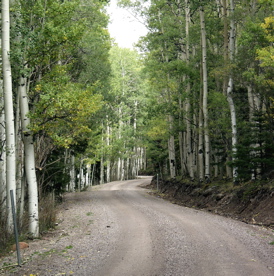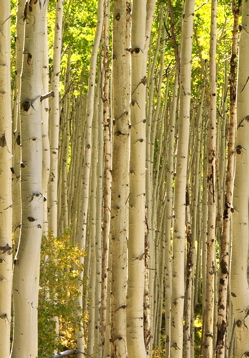
Learning From Nature's Emergent Creativity: Margaret Wheatley and the Aspen Trees
…Three images have changed my life — one, a picture of a chemical reaction,
another, a termite tower in Australia, and a third, an aspen grove in my new home state of Utah. Each image in its own way represents a profound shift in my understanding about the nature of change in organizations. —Organizational consultant and author, Margaret Wheatley, in an article titled The Unplanned Organization: Learning from Nature’s Emergent Creativity
Because of my gratitude and respect for the work of Margaret Wheatley, I wanted to reference this article before moving on to other blogging topics that are scratching at my brain. Superbly, Margaret goes on in this article to draw lessons from Nature’s Emergent Creativity, inspired by the photographs of a chemical reaction, the termite mound and the Aspen. Before addressing the Aspen Trees she references these lessons:
We live in a world in which life want to happen…
Organizations are living systems, or at least the people living in them are living systems…
We live in a universe that is alive, creative, and experimenting all the time to discover what’s possible…
Life uses messes to get well-order solutions…
Life is intent on finding what works, not what is right…
Life creates more possibilities as it engages with opportunities…
Life organizes around identity…
Margaret closes the article with this:
ASPEN TREES AND HIDDEN CONNECTEDNESS
 I recently learned from my son’s fifth grade teacher that the largest known living organism on the planet lives in Utah, where we now live. My son got excited and thought it was Bigfoot, but it’s not. It’s a grove of aspen trees that cover thousands of acres. When we look at them, we think, “Oh, look at all the trees.” When botanists looked underground they said, “Oh, look at this system, it’s all one. This is one organism.” You see, when aspen trees propagate, they don’t send out seeds or cones, they send out runners, and a runner runs for the light (there’s wonderful imagery in all of this), and we say, “Aha! There’s another tree . . .” until we look underground, and we see that it is all one vast connection.
I recently learned from my son’s fifth grade teacher that the largest known living organism on the planet lives in Utah, where we now live. My son got excited and thought it was Bigfoot, but it’s not. It’s a grove of aspen trees that cover thousands of acres. When we look at them, we think, “Oh, look at all the trees.” When botanists looked underground they said, “Oh, look at this system, it’s all one. This is one organism.” You see, when aspen trees propagate, they don’t send out seeds or cones, they send out runners, and a runner runs for the light (there’s wonderful imagery in all of this), and we say, “Aha! There’s another tree . . .” until we look underground, and we see that it is all one vast connection.
Before I was aware of the Utah aspens, I used to think that the Michigan mushroom, which covered 37 acres, was the largest organism. What was interesting about that was when mycologists looked at these mushrooms they couldn’t figure out how they survived, because they didn’t have all the “functionality” they needed to be healthy mushrooms. When they looked underground they found the answer — it was just one large organism.
In a self-organizing world, one of the things that works on our behalf is not only that we have a natural tendency toward change, that we can constantly reorganize, or that we can structure ourselves without leaders (as long as we’re well connected and informed and focused) but that, underneath it all, what we’re doing is discovering our connections.
One of the great teachings in chaos theory is that a very slight twitch in a connective system will create convulsions elsewhere. I’m sure you’ve had a negative version of this experience in which you made an offhand comment to somebody, and later it blew up in your face. Whereas you may have presented your life’s work, thinking it was the greatest gift to humankind, others just looked at it and said, “Well, that’s very nice, dear.”
Biologist Francisco Varela has said that you cannot direct a living system, you can only disturb it. In a system, the most we can do, when we are trying to serve, is to contribute a little twitch, be a little disturbance. One of the great things about living systems is that not only can they not be leveraged, they cannot be directed. You cannot tell another human being or a human organization what to do and expect it to do it. Yet this is not a lesson we have learned. It has been in our faces all our lives — especially if you’re a parent of a teenager (actually it starts much younger, with two-year-olds) that we can’t direct living things.
If we really start to sense the self-organizing capacity that is around us, we could realize that our efforts to foster change or to midwife change — not to manage change — have much support.
In my own work, I’m trying to feel more playful about it, and to take away some of the drama — “If we don’t get it right now, we’re all going to perish.” I believe that’s a true statement, but it doesn’t help me play with life the way I want to, the way in which I see life playing with us. I would like us just to be more experimental. We are not looking for the solutions, we’re just seeing what works for this system, with a deep respect for its interconnections. When it doesn’t work, we move on and try something else, and when it works, we feel very blessed.
Thanks for the inspirations, Meg.
Note: this article first appeared in the Noetic Sciences Review #37, Spring 1996. See my other posts on Aspen-Body Wisdom series here.

Kent
10/31/2007 at 1:53 amIf you are leaving the “Aspen Body” series for a while, this seems like a good time to say “thanks” to you and the Aspens for sharing valuable insights. Getting to some truths is much like getting to an Aspen grove which is a thousand vertical feet above you; you can get there straight on but it is easier to take some switchbacks and approach it obliquely. That may be the greatest value underneath the surface of your metaphor, you get us there in a way we can understand and without exhausting us in the climb.
Change Hardiness & Learning Agility: What the Aspen Know « wild resiliency blog!
01/06/2008 at 9:49 pm[…] Margaret writes about Aspens as an image of self-organizing systems and what we can learn from them. And yet I believe, and I’m confident she would agree, she only begins to open the windows of perception as to what we might be capable of learning from Aspens. […]
jannfreed
02/26/2009 at 2:20 amI love the metaphors and analogies with science and organizations. We are all connected and we feel it now more than ever in this economy. Thanks. Jann